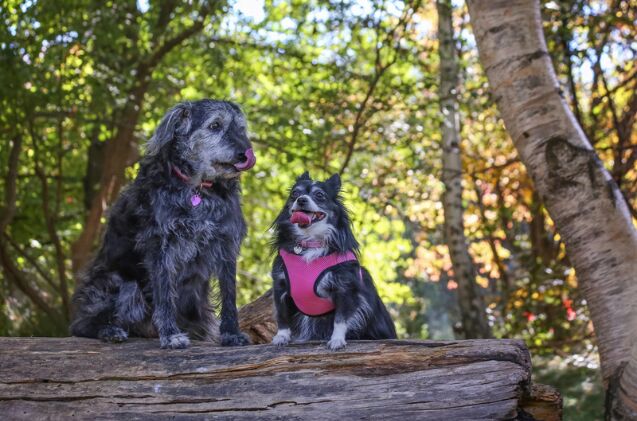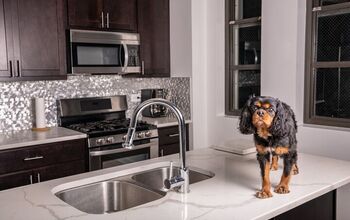What is the Best Dog Harness for Senior Dogs?

As our dogs age, their needs often change. Decisions we made for them as young pups no longer provide the safety, security, and comfort they need in their golden years. Many will suffer from mobility struggles during walks and daily activities. While there is no single tool that will offer a quick fix solution, turning back the hands of time and giving your dog their puppy body again, there are ways we can help provide support and comfort – like switching to a senior dog-friendly harness.
Let’s explore the unique requirements of our aging friends, discussing the features you should consider when choosing a harness suitable for their changing needs. From ease of use to better support, I aim to help you select the ideal harness to help your senior dog enjoy the best possible quality of life.
Are Harnesses Better for Older Dogs?
Which is better for a dog, a collar or a harness? It’s an age-old debate that has no definitive black-and-white solution. Both collars and harnesses are valuable tools that offer benefits and disadvantages, depending on your dog’s size, body shape, personality, and age. Your training style and your work together will also impact this.
Of course, like anything, the “best” solution may change over time.
As our dogs age, they lose muscle mass, making them more fragile and susceptible to injury. Wearing a collar runs the risk of injury from putting pressure directly on the neck. Harnesses distribute the pressure more evenly across a dog’s chest to prevent trouble.
A well-made harness can also be used to give your senior dog more support when needed. If you see your dog is unsteady or if they trip, you can grab onto the handles on the back of the harness to prevent an injury. Even if your dog isn’t at the age where they are showing signs of aging to that degree, a harness can make it easier to navigate obstacles and uneven ground safely.
Do Vets Recommend Harnesses?
As we already mentioned, there is no one-size-fits-all answer to the question of whether to use a harness or a collar. You will find veterinarians and experts who recommend each option, depending on the situation and their experiences.
If you are interested in the best recommendation for your dog specifically, it is recommended that you speak with your veterinarian. They know your dog well and will be able to suggest the best option specifically for them.
What to Consider When Shopping for a Harness for Your Senior Dog
If, after reading that, you decide that a harness is the better option for your senior dog, it’s time to go shopping. There are many different harnesses on the market, making it a challenge sometimes to decide where to start. To help you with your shopping journey, here are a few key factors to consider:
Material
You may have noticed that many different materials are emerging in the dog harness world. Each material has pros and cons, making it essential to consider which is best for your dog and your lifestyle.
Cloth harnesses are often more style-focused, with a wide assortment of colours and designs to choose from. Traditional nylon collars are also available in a wide range of colors. However, if you have a dog that tends to spend time outdoors in the dirt and mud, these harnesses will likely get stained and dirty very quickly. Some cloth harnesses are machine washable, while others require hand washing, making them a bigger commitment in terms of upkeep. If you don’t keep up with the cleaning necessary, this could put your dog at risk of skin irritation and infection from the harness carrying bacteria and germs.
A waterproof and easy-to-clean alternative is Biothane. While it still comes in many colors, the material is often stiff compared to nylon or cloth, which could make it uncomfortable for a sensitive older dog.
There is no “one-size-fits-all” answer regarding the best material for a dog harness. Instead, you must weigh the pros and cons and find the harness that best suits your (and your dog’s) needs.
Budget
Of course, any time you invest in quality dog gear, your budget is an important consideration. Take some time to determine a budget before you start shopping. This will help you narrow your options to those in your price range, making it easier to stick to your budget without feeling like you are missing out.
There are some great options available for budget-friendly shoppers! Alternatively, if you have your heart set on one of the bigger brand names, you may want to consider purchasing your dog’s harness second-hand. Not only is this a great way to save money, but you’re also making an environmentally friendly choice, which is important to many of us.
Soft, Comfortable Padding
As we already discussed, our senior dogs are often a little more fragile than they were in their younger years. This could result from muscle loss, joint problems, sensitive skin, or any other number of ways that aging has changed the body.
To ensure your dog is comfortable wearing their harness, check the material lining the inside. Is it soft and gentle on their skin? Does it run a risk of causing irritation? Is there padding in areas where the harness may come in contact with pressure points or areas of concern for your pup?
For example, a good friend has a 12-year-old lab that has recently experienced arthritis, primarily in her shoulders. When selecting a harness, she needs to ensure that the one she chooses is well-padded around the shoulder area to avoid causing any further discomfort.
Bulk and Weight
One consideration you may have overlooked is how the bulk or weight can impact your dog’s comfort level at this stage. While you may have loved the look of a tactical harness when your dog was a healthy adult pup, in their prime, it could be too heavy for the same dog later in life. Instead, it’s better to stick to a lightweight harness, allowing free movement without fighting the added weight.
Adjustability and Ease of Use
As dogs get older, they often struggle with changes in mobility. This can make it harder to manipulate their legs to get into a more elaborate dog harness. Instead, choose a harness that is as easy as possible to put on. This often means one that closes at the chest and stomach so that the harness can simply be placed on them and fastened in place.
Check how many adjustment points each harness offers. If your senior dog is uncomfortable in their harness, it could be too tight in one area. The more adjustment opportunities available, the easier it will be to customize the fit to suit your dog’s needs.
Full Body Support
If you are counting on using your dog’s harness to assist when they are shaky on their feet, help them navigate obstacles, or prevent a fall on uneven terrain, you want to ensure that the harness you choose offers full body support. This means it extends further down the body so that when you lift on the top of the harness, it also supports the torso.
Correct Sizing
Sizing is important when harnessing any dog, but it’s essential for a senior. If you are unsure about your dog’s sizing, consider bringing your dog with you shopping at your local pet store. This will allow you to try on different sizes to find the harness that fits them best.
The harness should be able to adjust so that it is snug, but you can still fit two fingers beneath the straps at any point. A harness that is too small can cause pain and discomfort, whereas if it’s too big, it won’t safely secure your dog and fails to offer the support you may be relying on.
What to Avoid in a Dog Harness
If you pay attention to the above guidelines for shopping, you are already on the right track. However, there are a few things you should avoid when buying a harness for a senior dog.
The most important thing to avoid is a harness that will limit or impact your dog’s mobility in any way. This is true for dogs of all ages but is especially vital when shopping for a senior. Check that the front of the harness doesn’t lie across the shoulders, restricting movement of the front legs. This is regularly seen in products labelled as “no pull.” Your older dog may already be dealing with changes in their mobility, and the goal is to find ways to make that easier, not harder.
Additionally, steer clear of harnesses with unnecessary extra parts or features. This could include pouches for their gear, elaborate added decorations, or anything that could add to the weight of the harness. Remember, a lightweight harness is best. The simpler the style, the less unnecessary weight you are expecting your dog to carry.
What Harnesses Do We Recommend?
As I previously mentioned, there is no one-size-fits-all solution when shopping for a harness. However, there are definitely some products that stand out on the market. Some of the products that I have tried or still use with my older dogs today that I would recommend include:
- Ruffwear Flagline Lightweight Lift-and-Assist Harness
- OneTigris Dog Lift Harness
- Coodeo Dog Lift Harness
How Do You Train an Older Dog to Wear a Harness?
If your older dog has been wearing a collar their whole life, introducing a harness suddenly could introduce unnecessary stress. Instead, consider ways to ease into it by slowly introducing your dog over time.
To begin, simply place the harness in a familiar room and allow them to check it out. They may take some time eyeing it from a distance before coming close to this new addition to their space. That’s okay! Give them time and allow them to explore it at their own pace. This includes walking around it, sniffing it, and becoming comfortable with its presence.
When your dog appears ready, try placing it on their back for a second before removing it and offering a reward or praise. Try latching the harness for just a second. When they are comfortable with that, you can start to extend the time that it is latched before removing it. The goal is to create a positive association.
If, at any point, you feel your dog is upset or showing signs of anxiety, take a step back. Go back to a prior stage and focus on making it positive. This could take a day, or it could take a week. But investing the time to do it properly now will set you up for success for the rest of your dog’s life.
Final Thoughts – The Best Harness for Senior Dogs
Many veterinarians and experts on the health and care of senior dogs will recommend using a harness. However, not all harnesses are created to meet the needs of every life stage. When selecting a harness for an older dog, there are unique factors to consider. This includes the weight and bulkiness of the harness, how easy it is to put it on/take it off, and the padding inside the harness for their comfort. Pay careful attention to ensure the design or fit doesn’t limit or impact movement.
There are many great harness options on the market, including those made for regular wear and specialized lift support harnesses with convenient shoulder straps.
If possible, visit your local pet store with your senior dog to check out your options firsthand. This will help you better assess the size needed and whether the design suits your dog’s unique needs. Most importantly, remember that there is no “one-size-fits-all” solution. You may find that you are using two different harnesses with two senior dogs in your home. That’s okay! The goal is to find the option that supports all your dog’s needs and helps you give them the best possible quality of life.
Join the PetGuide community. Get the latest pet news and product recommendations by subscribing to our newsletter here.

Britt Kascjak is a proud pet mom, sharing her heart (and her home) with her “pack” which includes her husband John, their 2 dogs – Indiana and Lucifer – and their 2 cats – Pippen and Jinx. She has been active in the animal rescue community for over 15 years, volunteering, fostering and advocating for organizations across Canada and the US. In her free time, she enjoys traveling around the country camping, hiking, and canoeing with her pets.
More by Britt























